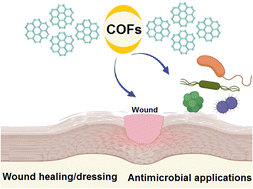Recent advances in covalent organic frameworks (COFs) for wound healing and antimicrobial applications
Abstract
Covalent organic frameworks (COFs) are crystal-like organic structures such as cartography buildings prepared from appropriately pre-designed construction block precursors. Moreover, after the expansion of the first COF in 2005, numerous researchers have been developing different materials for versatile applications such as sensing/imaging, cancer theranostics, drug delivery, tissue engineering, wound healing, and antimicrobials. COFs have harmonious pore size, enduring porosity, thermal stability, and low density. In addition, a wide variety of functional groups could be implanted during their construction to provide desired constituents, including antibodies and enzymes. The reticular organic frameworks comprising porous hybrid materials connected via a covalent bond have been studied for improving wound healing and dressing applications due to their long-standing antibacterial properties. Several COF-based systems have been planned for controlled drug delivery with wound healing purposes, targeting drugs to efficiently inhibit the growth of pathogenic microorganisms at the wound spot. In addition, COFs can be deployed for combinational therapy using photodynamic and photothermal antibacterial therapy along with drug delivery for healing chronic wounds and bacterial infections. Herein, the most recent advancements pertaining to the applications of COF-based systems against bacterial infections and for wound healing are considered, concentrating on challenges and future guidelines.

- This article is part of the themed collection: 2022 Reviews in RSC Advances


 Please wait while we load your content...
Please wait while we load your content...